International Business Strategy: Analysis for Flower Exporter
VerifiedAdded on 2020/03/01
|13
|3667
|128
Report
AI Summary
This report analyzes the international business strategy for an Australian flower exporter, Adam, who currently sells flowers to a middleman for export to Northern Europe. The core issue addressed is how Adam can increase profitability by directly exporting to florists and customers. The report provides background information on the existing business model and the market dynamics, including competitors and demand. It explores relevant theories and concepts, such as resource-based theory, transaction cost economics, resource dependence theory, strategic management frameworks, and the knowledge-based view, to formulate alternative strategies. Two alternative strategies are presented, focusing on infrastructure investment, technological advancements, packaging, and hydroponics. The report recommends the second strategy, which involves a combination of selling to the middleman and direct exporting to florists, alongside market research, employee recruitment, and currency considerations. The report emphasizes the importance of direct customer connections and brand recognition for maximizing profits and mitigating risks associated with relying on a middleman.
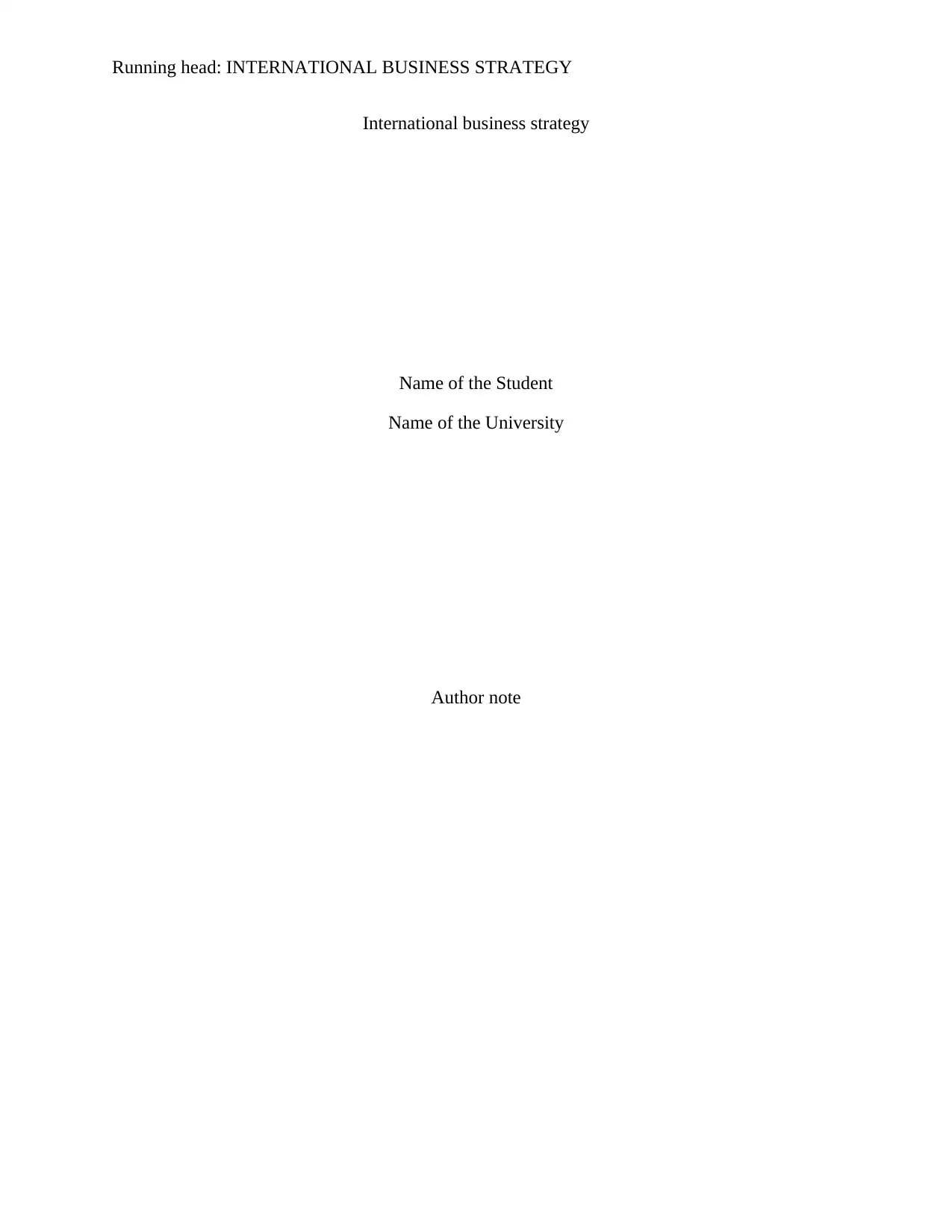
Running head: INTERNATIONAL BUSINESS STRATEGY
International business strategy
Name of the Student
Name of the University
Author note
International business strategy
Name of the Student
Name of the University
Author note
Paraphrase This Document
Need a fresh take? Get an instant paraphrase of this document with our AI Paraphraser
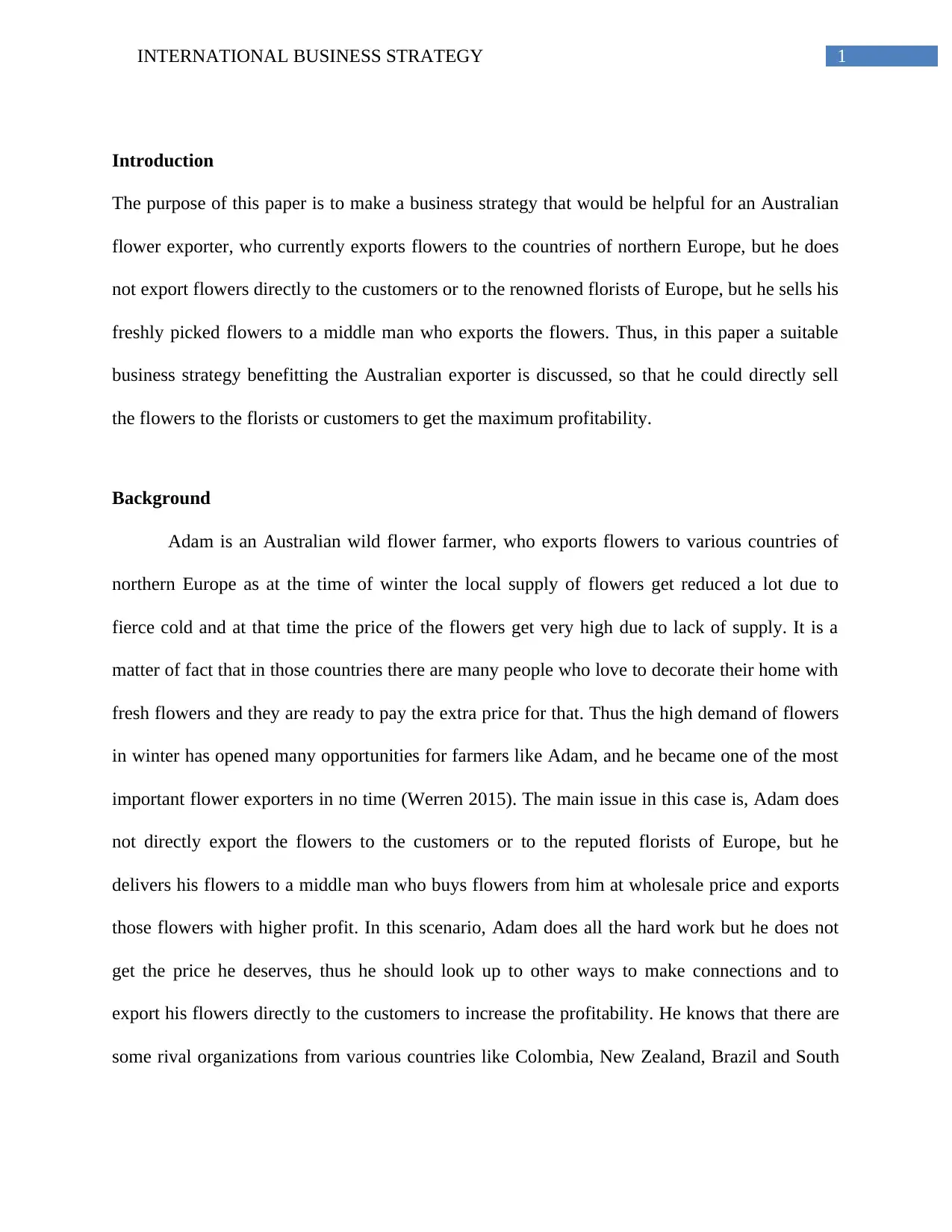
1INTERNATIONAL BUSINESS STRATEGY
Introduction
The purpose of this paper is to make a business strategy that would be helpful for an Australian
flower exporter, who currently exports flowers to the countries of northern Europe, but he does
not export flowers directly to the customers or to the renowned florists of Europe, but he sells his
freshly picked flowers to a middle man who exports the flowers. Thus, in this paper a suitable
business strategy benefitting the Australian exporter is discussed, so that he could directly sell
the flowers to the florists or customers to get the maximum profitability.
Background
Adam is an Australian wild flower farmer, who exports flowers to various countries of
northern Europe as at the time of winter the local supply of flowers get reduced a lot due to
fierce cold and at that time the price of the flowers get very high due to lack of supply. It is a
matter of fact that in those countries there are many people who love to decorate their home with
fresh flowers and they are ready to pay the extra price for that. Thus the high demand of flowers
in winter has opened many opportunities for farmers like Adam, and he became one of the most
important flower exporters in no time (Werren 2015). The main issue in this case is, Adam does
not directly export the flowers to the customers or to the reputed florists of Europe, but he
delivers his flowers to a middle man who buys flowers from him at wholesale price and exports
those flowers with higher profit. In this scenario, Adam does all the hard work but he does not
get the price he deserves, thus he should look up to other ways to make connections and to
export his flowers directly to the customers to increase the profitability. He knows that there are
some rival organizations from various countries like Colombia, New Zealand, Brazil and South
Introduction
The purpose of this paper is to make a business strategy that would be helpful for an Australian
flower exporter, who currently exports flowers to the countries of northern Europe, but he does
not export flowers directly to the customers or to the renowned florists of Europe, but he sells his
freshly picked flowers to a middle man who exports the flowers. Thus, in this paper a suitable
business strategy benefitting the Australian exporter is discussed, so that he could directly sell
the flowers to the florists or customers to get the maximum profitability.
Background
Adam is an Australian wild flower farmer, who exports flowers to various countries of
northern Europe as at the time of winter the local supply of flowers get reduced a lot due to
fierce cold and at that time the price of the flowers get very high due to lack of supply. It is a
matter of fact that in those countries there are many people who love to decorate their home with
fresh flowers and they are ready to pay the extra price for that. Thus the high demand of flowers
in winter has opened many opportunities for farmers like Adam, and he became one of the most
important flower exporters in no time (Werren 2015). The main issue in this case is, Adam does
not directly export the flowers to the customers or to the reputed florists of Europe, but he
delivers his flowers to a middle man who buys flowers from him at wholesale price and exports
those flowers with higher profit. In this scenario, Adam does all the hard work but he does not
get the price he deserves, thus he should look up to other ways to make connections and to
export his flowers directly to the customers to increase the profitability. He knows that there are
some rival organizations from various countries like Colombia, New Zealand, Brazil and South
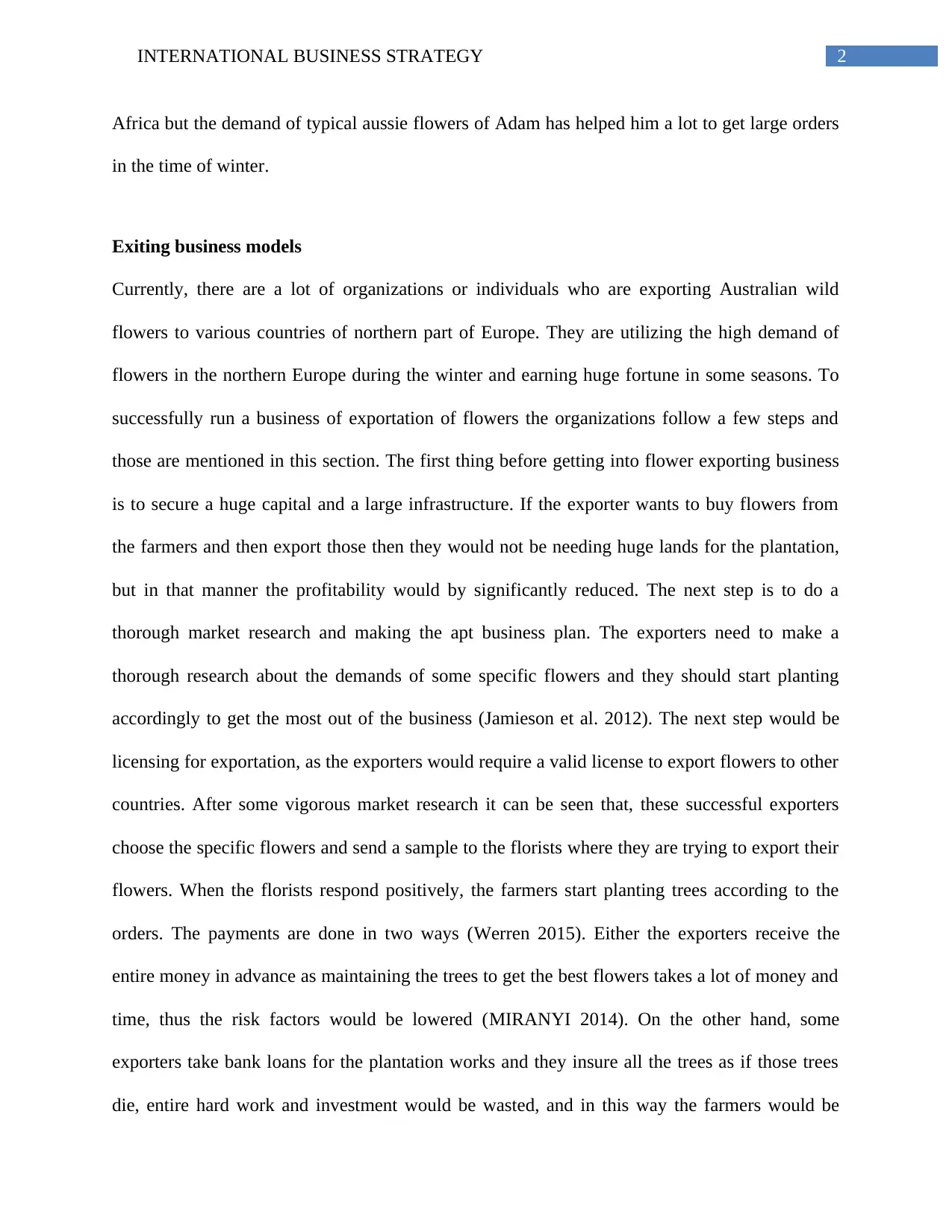
2INTERNATIONAL BUSINESS STRATEGY
Africa but the demand of typical aussie flowers of Adam has helped him a lot to get large orders
in the time of winter.
Exiting business models
Currently, there are a lot of organizations or individuals who are exporting Australian wild
flowers to various countries of northern part of Europe. They are utilizing the high demand of
flowers in the northern Europe during the winter and earning huge fortune in some seasons. To
successfully run a business of exportation of flowers the organizations follow a few steps and
those are mentioned in this section. The first thing before getting into flower exporting business
is to secure a huge capital and a large infrastructure. If the exporter wants to buy flowers from
the farmers and then export those then they would not be needing huge lands for the plantation,
but in that manner the profitability would by significantly reduced. The next step is to do a
thorough market research and making the apt business plan. The exporters need to make a
thorough research about the demands of some specific flowers and they should start planting
accordingly to get the most out of the business (Jamieson et al. 2012). The next step would be
licensing for exportation, as the exporters would require a valid license to export flowers to other
countries. After some vigorous market research it can be seen that, these successful exporters
choose the specific flowers and send a sample to the florists where they are trying to export their
flowers. When the florists respond positively, the farmers start planting trees according to the
orders. The payments are done in two ways (Werren 2015). Either the exporters receive the
entire money in advance as maintaining the trees to get the best flowers takes a lot of money and
time, thus the risk factors would be lowered (MIRANYI 2014). On the other hand, some
exporters take bank loans for the plantation works and they insure all the trees as if those trees
die, entire hard work and investment would be wasted, and in this way the farmers would be
Africa but the demand of typical aussie flowers of Adam has helped him a lot to get large orders
in the time of winter.
Exiting business models
Currently, there are a lot of organizations or individuals who are exporting Australian wild
flowers to various countries of northern part of Europe. They are utilizing the high demand of
flowers in the northern Europe during the winter and earning huge fortune in some seasons. To
successfully run a business of exportation of flowers the organizations follow a few steps and
those are mentioned in this section. The first thing before getting into flower exporting business
is to secure a huge capital and a large infrastructure. If the exporter wants to buy flowers from
the farmers and then export those then they would not be needing huge lands for the plantation,
but in that manner the profitability would by significantly reduced. The next step is to do a
thorough market research and making the apt business plan. The exporters need to make a
thorough research about the demands of some specific flowers and they should start planting
accordingly to get the most out of the business (Jamieson et al. 2012). The next step would be
licensing for exportation, as the exporters would require a valid license to export flowers to other
countries. After some vigorous market research it can be seen that, these successful exporters
choose the specific flowers and send a sample to the florists where they are trying to export their
flowers. When the florists respond positively, the farmers start planting trees according to the
orders. The payments are done in two ways (Werren 2015). Either the exporters receive the
entire money in advance as maintaining the trees to get the best flowers takes a lot of money and
time, thus the risk factors would be lowered (MIRANYI 2014). On the other hand, some
exporters take bank loans for the plantation works and they insure all the trees as if those trees
die, entire hard work and investment would be wasted, and in this way the farmers would be
⊘ This is a preview!⊘
Do you want full access?
Subscribe today to unlock all pages.

Trusted by 1+ million students worldwide
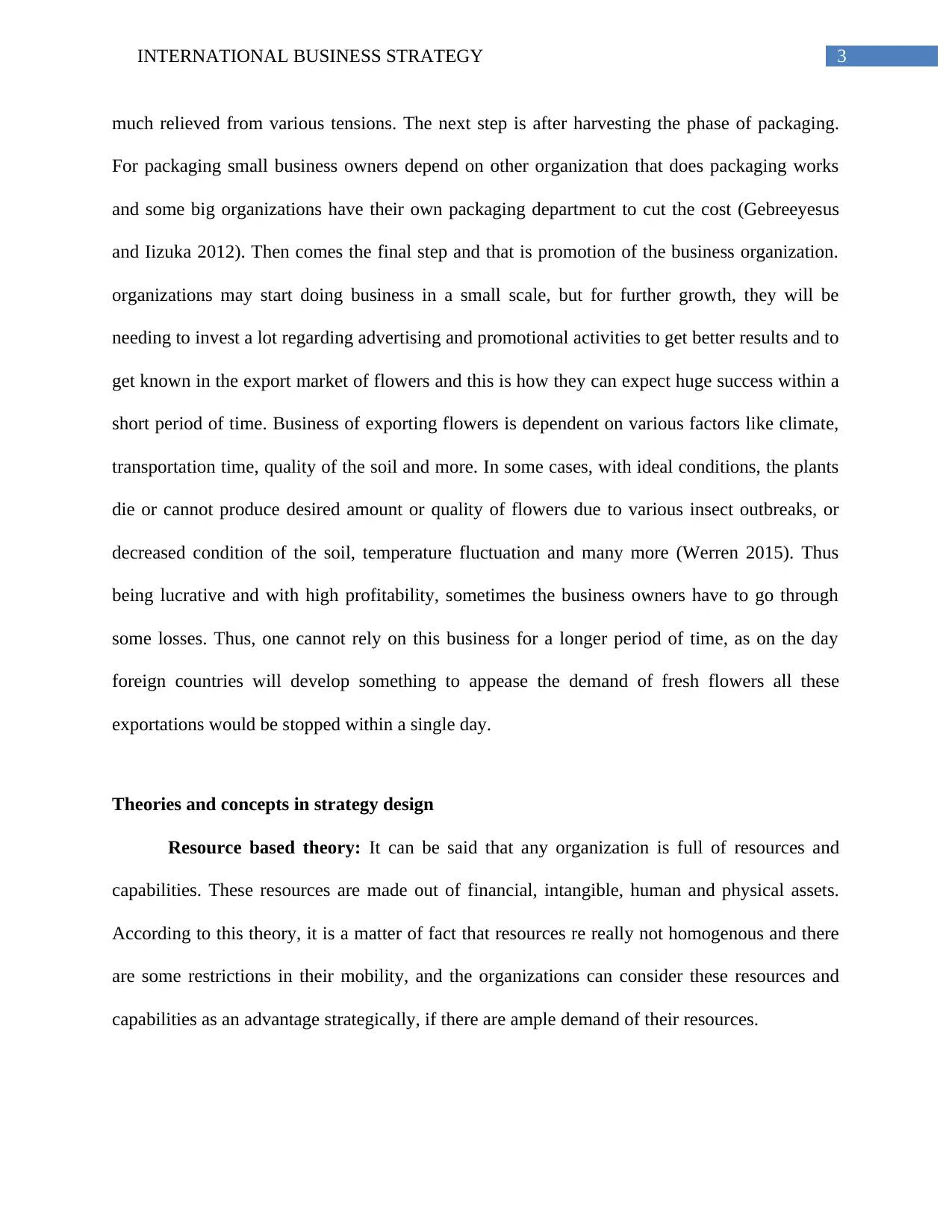
3INTERNATIONAL BUSINESS STRATEGY
much relieved from various tensions. The next step is after harvesting the phase of packaging.
For packaging small business owners depend on other organization that does packaging works
and some big organizations have their own packaging department to cut the cost (Gebreeyesus
and Iizuka 2012). Then comes the final step and that is promotion of the business organization.
organizations may start doing business in a small scale, but for further growth, they will be
needing to invest a lot regarding advertising and promotional activities to get better results and to
get known in the export market of flowers and this is how they can expect huge success within a
short period of time. Business of exporting flowers is dependent on various factors like climate,
transportation time, quality of the soil and more. In some cases, with ideal conditions, the plants
die or cannot produce desired amount or quality of flowers due to various insect outbreaks, or
decreased condition of the soil, temperature fluctuation and many more (Werren 2015). Thus
being lucrative and with high profitability, sometimes the business owners have to go through
some losses. Thus, one cannot rely on this business for a longer period of time, as on the day
foreign countries will develop something to appease the demand of fresh flowers all these
exportations would be stopped within a single day.
Theories and concepts in strategy design
Resource based theory: It can be said that any organization is full of resources and
capabilities. These resources are made out of financial, intangible, human and physical assets.
According to this theory, it is a matter of fact that resources re really not homogenous and there
are some restrictions in their mobility, and the organizations can consider these resources and
capabilities as an advantage strategically, if there are ample demand of their resources.
much relieved from various tensions. The next step is after harvesting the phase of packaging.
For packaging small business owners depend on other organization that does packaging works
and some big organizations have their own packaging department to cut the cost (Gebreeyesus
and Iizuka 2012). Then comes the final step and that is promotion of the business organization.
organizations may start doing business in a small scale, but for further growth, they will be
needing to invest a lot regarding advertising and promotional activities to get better results and to
get known in the export market of flowers and this is how they can expect huge success within a
short period of time. Business of exporting flowers is dependent on various factors like climate,
transportation time, quality of the soil and more. In some cases, with ideal conditions, the plants
die or cannot produce desired amount or quality of flowers due to various insect outbreaks, or
decreased condition of the soil, temperature fluctuation and many more (Werren 2015). Thus
being lucrative and with high profitability, sometimes the business owners have to go through
some losses. Thus, one cannot rely on this business for a longer period of time, as on the day
foreign countries will develop something to appease the demand of fresh flowers all these
exportations would be stopped within a single day.
Theories and concepts in strategy design
Resource based theory: It can be said that any organization is full of resources and
capabilities. These resources are made out of financial, intangible, human and physical assets.
According to this theory, it is a matter of fact that resources re really not homogenous and there
are some restrictions in their mobility, and the organizations can consider these resources and
capabilities as an advantage strategically, if there are ample demand of their resources.
Paraphrase This Document
Need a fresh take? Get an instant paraphrase of this document with our AI Paraphraser
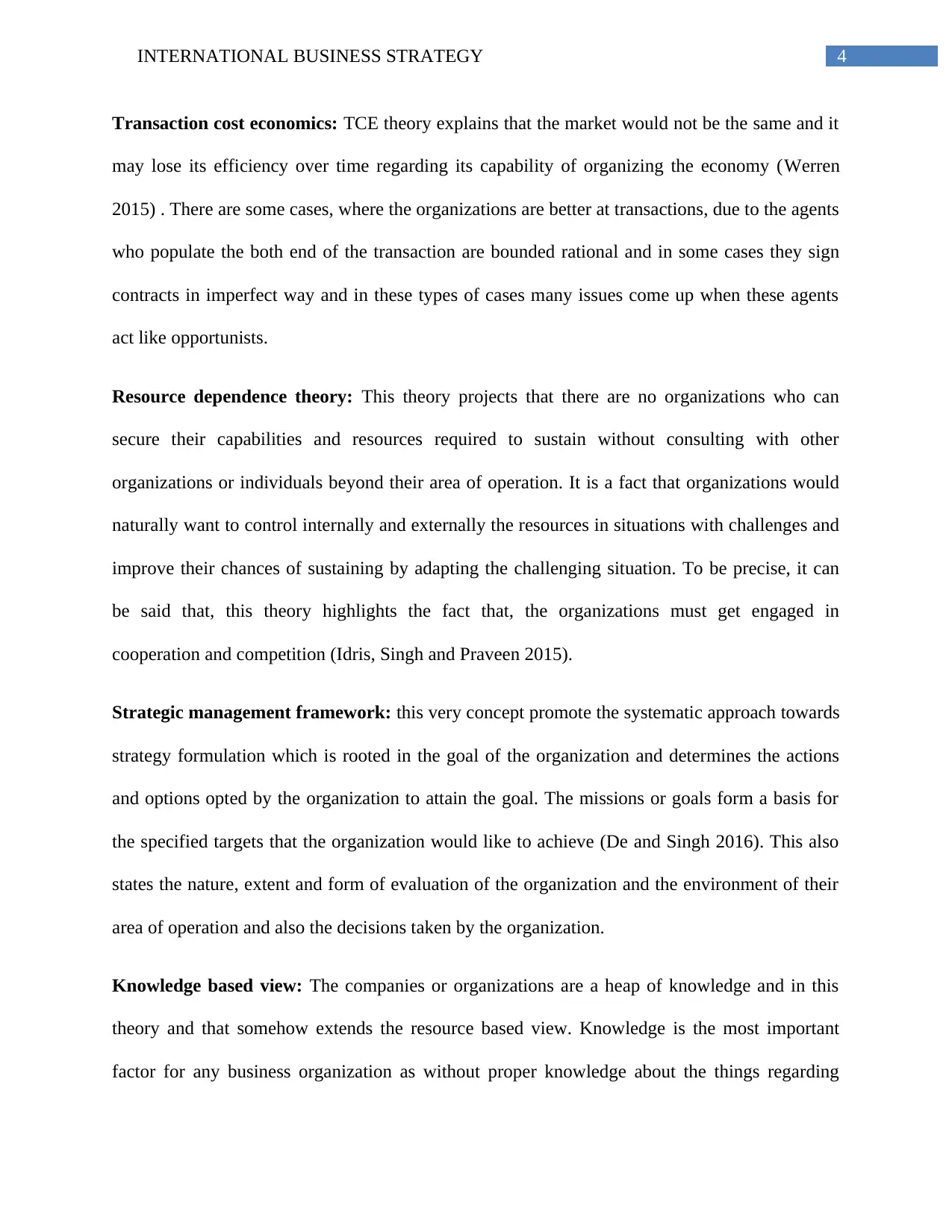
4INTERNATIONAL BUSINESS STRATEGY
Transaction cost economics: TCE theory explains that the market would not be the same and it
may lose its efficiency over time regarding its capability of organizing the economy (Werren
2015) . There are some cases, where the organizations are better at transactions, due to the agents
who populate the both end of the transaction are bounded rational and in some cases they sign
contracts in imperfect way and in these types of cases many issues come up when these agents
act like opportunists.
Resource dependence theory: This theory projects that there are no organizations who can
secure their capabilities and resources required to sustain without consulting with other
organizations or individuals beyond their area of operation. It is a fact that organizations would
naturally want to control internally and externally the resources in situations with challenges and
improve their chances of sustaining by adapting the challenging situation. To be precise, it can
be said that, this theory highlights the fact that, the organizations must get engaged in
cooperation and competition (Idris, Singh and Praveen 2015).
Strategic management framework: this very concept promote the systematic approach towards
strategy formulation which is rooted in the goal of the organization and determines the actions
and options opted by the organization to attain the goal. The missions or goals form a basis for
the specified targets that the organization would like to achieve (De and Singh 2016). This also
states the nature, extent and form of evaluation of the organization and the environment of their
area of operation and also the decisions taken by the organization.
Knowledge based view: The companies or organizations are a heap of knowledge and in this
theory and that somehow extends the resource based view. Knowledge is the most important
factor for any business organization as without proper knowledge about the things regarding
Transaction cost economics: TCE theory explains that the market would not be the same and it
may lose its efficiency over time regarding its capability of organizing the economy (Werren
2015) . There are some cases, where the organizations are better at transactions, due to the agents
who populate the both end of the transaction are bounded rational and in some cases they sign
contracts in imperfect way and in these types of cases many issues come up when these agents
act like opportunists.
Resource dependence theory: This theory projects that there are no organizations who can
secure their capabilities and resources required to sustain without consulting with other
organizations or individuals beyond their area of operation. It is a fact that organizations would
naturally want to control internally and externally the resources in situations with challenges and
improve their chances of sustaining by adapting the challenging situation. To be precise, it can
be said that, this theory highlights the fact that, the organizations must get engaged in
cooperation and competition (Idris, Singh and Praveen 2015).
Strategic management framework: this very concept promote the systematic approach towards
strategy formulation which is rooted in the goal of the organization and determines the actions
and options opted by the organization to attain the goal. The missions or goals form a basis for
the specified targets that the organization would like to achieve (De and Singh 2016). This also
states the nature, extent and form of evaluation of the organization and the environment of their
area of operation and also the decisions taken by the organization.
Knowledge based view: The companies or organizations are a heap of knowledge and in this
theory and that somehow extends the resource based view. Knowledge is the most important
factor for any business organization as without proper knowledge about the things regarding
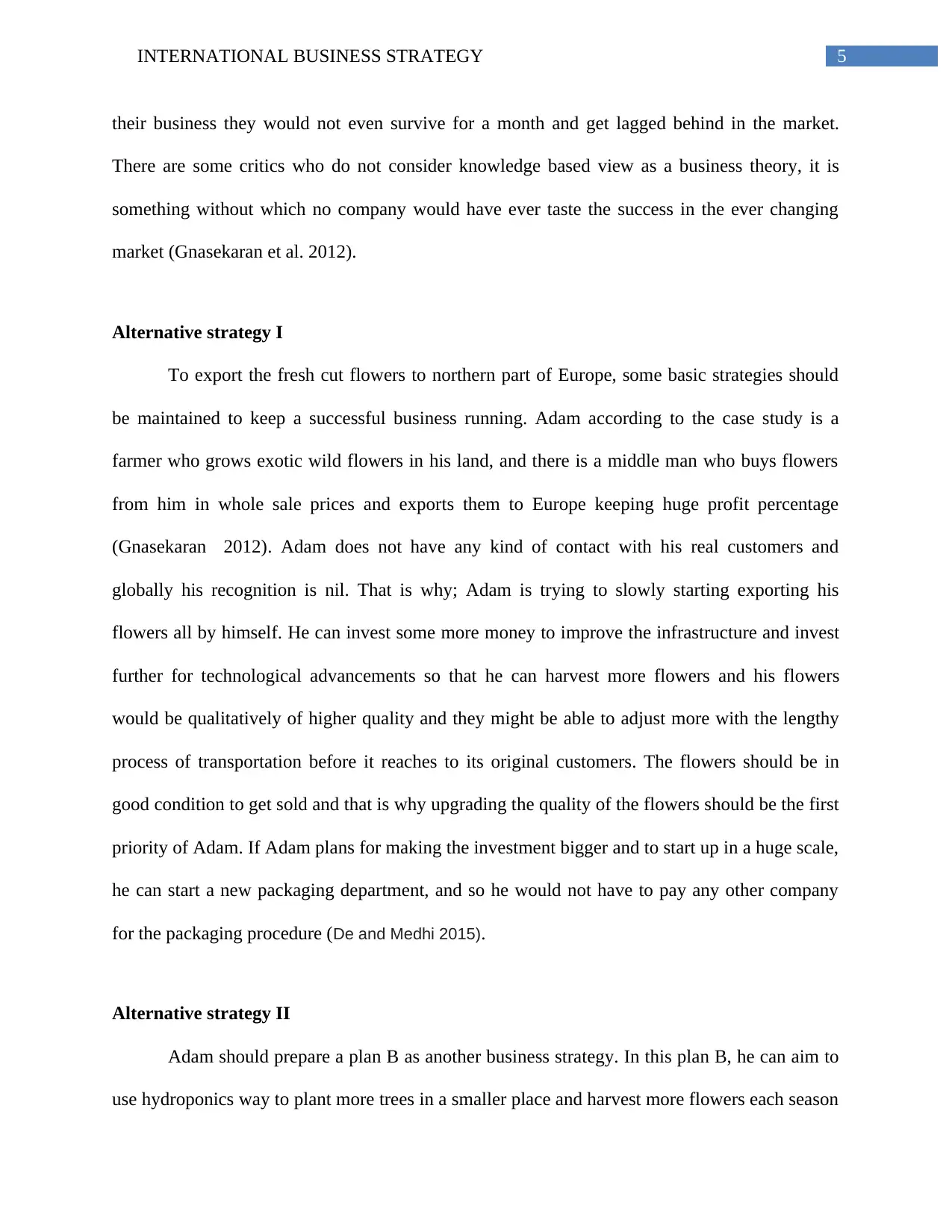
5INTERNATIONAL BUSINESS STRATEGY
their business they would not even survive for a month and get lagged behind in the market.
There are some critics who do not consider knowledge based view as a business theory, it is
something without which no company would have ever taste the success in the ever changing
market (Gnasekaran et al. 2012).
Alternative strategy I
To export the fresh cut flowers to northern part of Europe, some basic strategies should
be maintained to keep a successful business running. Adam according to the case study is a
farmer who grows exotic wild flowers in his land, and there is a middle man who buys flowers
from him in whole sale prices and exports them to Europe keeping huge profit percentage
(Gnasekaran 2012). Adam does not have any kind of contact with his real customers and
globally his recognition is nil. That is why; Adam is trying to slowly starting exporting his
flowers all by himself. He can invest some more money to improve the infrastructure and invest
further for technological advancements so that he can harvest more flowers and his flowers
would be qualitatively of higher quality and they might be able to adjust more with the lengthy
process of transportation before it reaches to its original customers. The flowers should be in
good condition to get sold and that is why upgrading the quality of the flowers should be the first
priority of Adam. If Adam plans for making the investment bigger and to start up in a huge scale,
he can start a new packaging department, and so he would not have to pay any other company
for the packaging procedure (De and Medhi 2015).
Alternative strategy II
Adam should prepare a plan B as another business strategy. In this plan B, he can aim to
use hydroponics way to plant more trees in a smaller place and harvest more flowers each season
their business they would not even survive for a month and get lagged behind in the market.
There are some critics who do not consider knowledge based view as a business theory, it is
something without which no company would have ever taste the success in the ever changing
market (Gnasekaran et al. 2012).
Alternative strategy I
To export the fresh cut flowers to northern part of Europe, some basic strategies should
be maintained to keep a successful business running. Adam according to the case study is a
farmer who grows exotic wild flowers in his land, and there is a middle man who buys flowers
from him in whole sale prices and exports them to Europe keeping huge profit percentage
(Gnasekaran 2012). Adam does not have any kind of contact with his real customers and
globally his recognition is nil. That is why; Adam is trying to slowly starting exporting his
flowers all by himself. He can invest some more money to improve the infrastructure and invest
further for technological advancements so that he can harvest more flowers and his flowers
would be qualitatively of higher quality and they might be able to adjust more with the lengthy
process of transportation before it reaches to its original customers. The flowers should be in
good condition to get sold and that is why upgrading the quality of the flowers should be the first
priority of Adam. If Adam plans for making the investment bigger and to start up in a huge scale,
he can start a new packaging department, and so he would not have to pay any other company
for the packaging procedure (De and Medhi 2015).
Alternative strategy II
Adam should prepare a plan B as another business strategy. In this plan B, he can aim to
use hydroponics way to plant more trees in a smaller place and harvest more flowers each season
⊘ This is a preview!⊘
Do you want full access?
Subscribe today to unlock all pages.

Trusted by 1+ million students worldwide
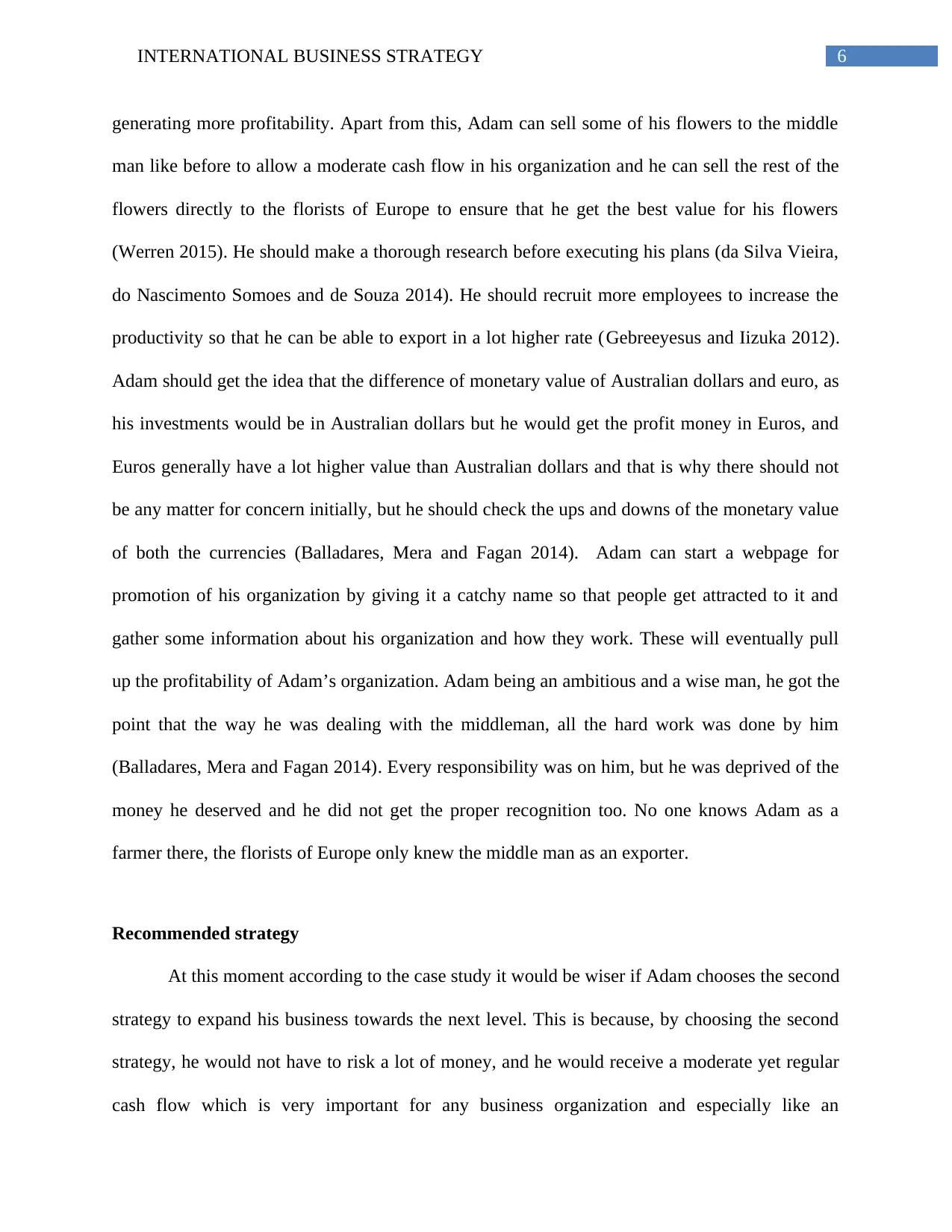
6INTERNATIONAL BUSINESS STRATEGY
generating more profitability. Apart from this, Adam can sell some of his flowers to the middle
man like before to allow a moderate cash flow in his organization and he can sell the rest of the
flowers directly to the florists of Europe to ensure that he get the best value for his flowers
(Werren 2015). He should make a thorough research before executing his plans (da Silva Vieira,
do Nascimento Somoes and de Souza 2014). He should recruit more employees to increase the
productivity so that he can be able to export in a lot higher rate (Gebreeyesus and Iizuka 2012).
Adam should get the idea that the difference of monetary value of Australian dollars and euro, as
his investments would be in Australian dollars but he would get the profit money in Euros, and
Euros generally have a lot higher value than Australian dollars and that is why there should not
be any matter for concern initially, but he should check the ups and downs of the monetary value
of both the currencies (Balladares, Mera and Fagan 2014). Adam can start a webpage for
promotion of his organization by giving it a catchy name so that people get attracted to it and
gather some information about his organization and how they work. These will eventually pull
up the profitability of Adam’s organization. Adam being an ambitious and a wise man, he got the
point that the way he was dealing with the middleman, all the hard work was done by him
(Balladares, Mera and Fagan 2014). Every responsibility was on him, but he was deprived of the
money he deserved and he did not get the proper recognition too. No one knows Adam as a
farmer there, the florists of Europe only knew the middle man as an exporter.
Recommended strategy
At this moment according to the case study it would be wiser if Adam chooses the second
strategy to expand his business towards the next level. This is because, by choosing the second
strategy, he would not have to risk a lot of money, and he would receive a moderate yet regular
cash flow which is very important for any business organization and especially like an
generating more profitability. Apart from this, Adam can sell some of his flowers to the middle
man like before to allow a moderate cash flow in his organization and he can sell the rest of the
flowers directly to the florists of Europe to ensure that he get the best value for his flowers
(Werren 2015). He should make a thorough research before executing his plans (da Silva Vieira,
do Nascimento Somoes and de Souza 2014). He should recruit more employees to increase the
productivity so that he can be able to export in a lot higher rate (Gebreeyesus and Iizuka 2012).
Adam should get the idea that the difference of monetary value of Australian dollars and euro, as
his investments would be in Australian dollars but he would get the profit money in Euros, and
Euros generally have a lot higher value than Australian dollars and that is why there should not
be any matter for concern initially, but he should check the ups and downs of the monetary value
of both the currencies (Balladares, Mera and Fagan 2014). Adam can start a webpage for
promotion of his organization by giving it a catchy name so that people get attracted to it and
gather some information about his organization and how they work. These will eventually pull
up the profitability of Adam’s organization. Adam being an ambitious and a wise man, he got the
point that the way he was dealing with the middleman, all the hard work was done by him
(Balladares, Mera and Fagan 2014). Every responsibility was on him, but he was deprived of the
money he deserved and he did not get the proper recognition too. No one knows Adam as a
farmer there, the florists of Europe only knew the middle man as an exporter.
Recommended strategy
At this moment according to the case study it would be wiser if Adam chooses the second
strategy to expand his business towards the next level. This is because, by choosing the second
strategy, he would not have to risk a lot of money, and he would receive a moderate yet regular
cash flow which is very important for any business organization and especially like an
Paraphrase This Document
Need a fresh take? Get an instant paraphrase of this document with our AI Paraphraser
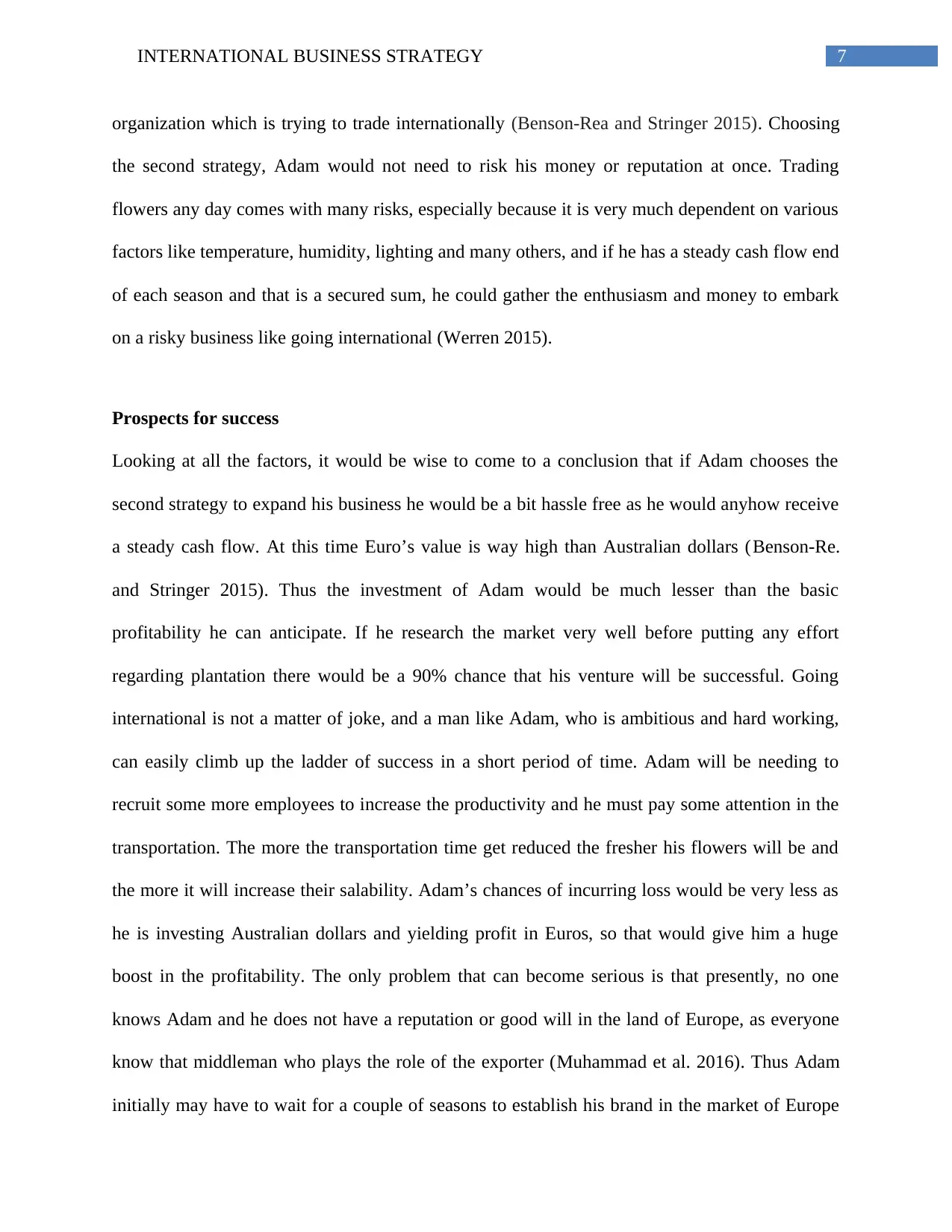
7INTERNATIONAL BUSINESS STRATEGY
organization which is trying to trade internationally (Benson-Rea and Stringer 2015). Choosing
the second strategy, Adam would not need to risk his money or reputation at once. Trading
flowers any day comes with many risks, especially because it is very much dependent on various
factors like temperature, humidity, lighting and many others, and if he has a steady cash flow end
of each season and that is a secured sum, he could gather the enthusiasm and money to embark
on a risky business like going international (Werren 2015).
Prospects for success
Looking at all the factors, it would be wise to come to a conclusion that if Adam chooses the
second strategy to expand his business he would be a bit hassle free as he would anyhow receive
a steady cash flow. At this time Euro’s value is way high than Australian dollars (Benson-Re.
and Stringer 2015). Thus the investment of Adam would be much lesser than the basic
profitability he can anticipate. If he research the market very well before putting any effort
regarding plantation there would be a 90% chance that his venture will be successful. Going
international is not a matter of joke, and a man like Adam, who is ambitious and hard working,
can easily climb up the ladder of success in a short period of time. Adam will be needing to
recruit some more employees to increase the productivity and he must pay some attention in the
transportation. The more the transportation time get reduced the fresher his flowers will be and
the more it will increase their salability. Adam’s chances of incurring loss would be very less as
he is investing Australian dollars and yielding profit in Euros, so that would give him a huge
boost in the profitability. The only problem that can become serious is that presently, no one
knows Adam and he does not have a reputation or good will in the land of Europe, as everyone
know that middleman who plays the role of the exporter (Muhammad et al. 2016). Thus Adam
initially may have to wait for a couple of seasons to establish his brand in the market of Europe
organization which is trying to trade internationally (Benson-Rea and Stringer 2015). Choosing
the second strategy, Adam would not need to risk his money or reputation at once. Trading
flowers any day comes with many risks, especially because it is very much dependent on various
factors like temperature, humidity, lighting and many others, and if he has a steady cash flow end
of each season and that is a secured sum, he could gather the enthusiasm and money to embark
on a risky business like going international (Werren 2015).
Prospects for success
Looking at all the factors, it would be wise to come to a conclusion that if Adam chooses the
second strategy to expand his business he would be a bit hassle free as he would anyhow receive
a steady cash flow. At this time Euro’s value is way high than Australian dollars (Benson-Re.
and Stringer 2015). Thus the investment of Adam would be much lesser than the basic
profitability he can anticipate. If he research the market very well before putting any effort
regarding plantation there would be a 90% chance that his venture will be successful. Going
international is not a matter of joke, and a man like Adam, who is ambitious and hard working,
can easily climb up the ladder of success in a short period of time. Adam will be needing to
recruit some more employees to increase the productivity and he must pay some attention in the
transportation. The more the transportation time get reduced the fresher his flowers will be and
the more it will increase their salability. Adam’s chances of incurring loss would be very less as
he is investing Australian dollars and yielding profit in Euros, so that would give him a huge
boost in the profitability. The only problem that can become serious is that presently, no one
knows Adam and he does not have a reputation or good will in the land of Europe, as everyone
know that middleman who plays the role of the exporter (Muhammad et al. 2016). Thus Adam
initially may have to wait for a couple of seasons to establish his brand in the market of Europe
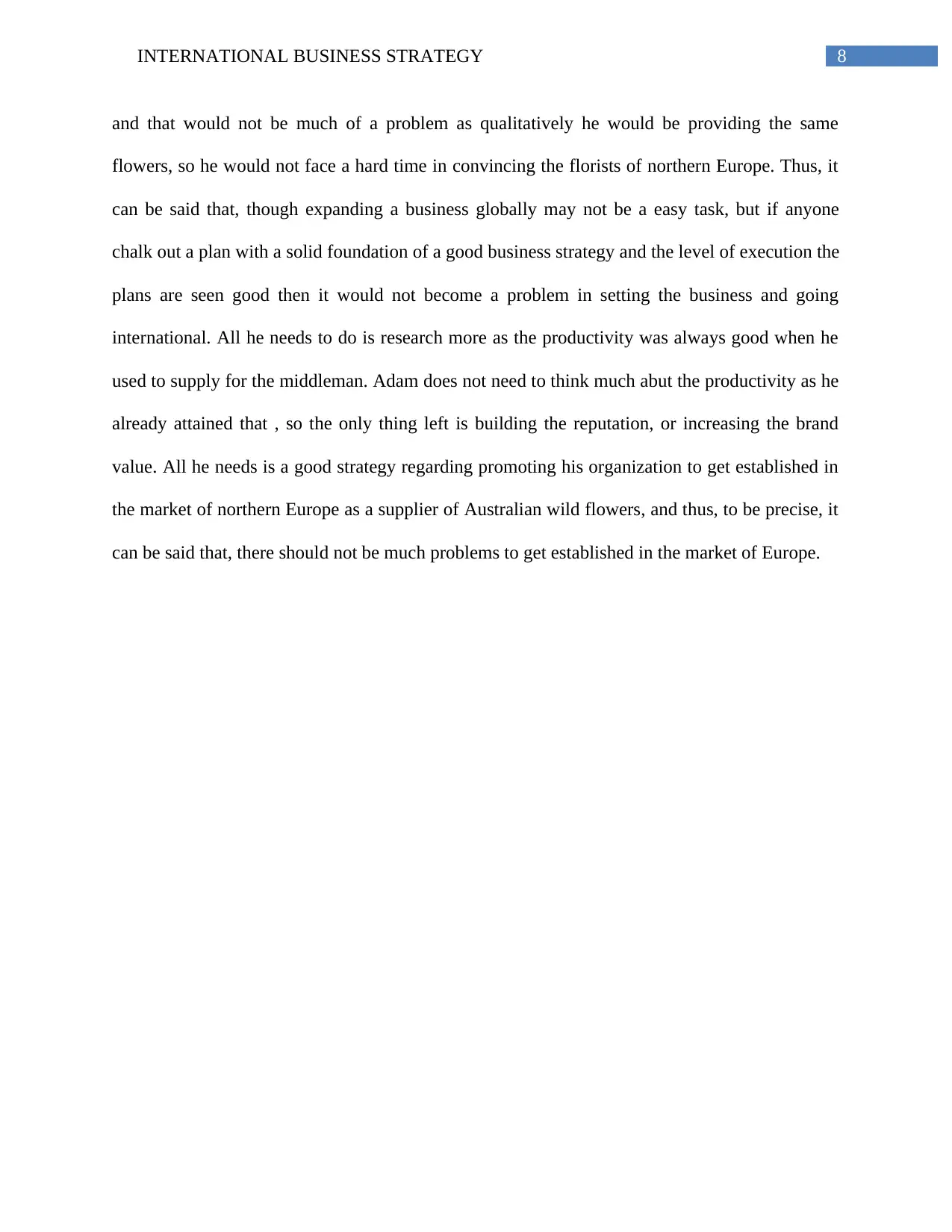
8INTERNATIONAL BUSINESS STRATEGY
and that would not be much of a problem as qualitatively he would be providing the same
flowers, so he would not face a hard time in convincing the florists of northern Europe. Thus, it
can be said that, though expanding a business globally may not be a easy task, but if anyone
chalk out a plan with a solid foundation of a good business strategy and the level of execution the
plans are seen good then it would not become a problem in setting the business and going
international. All he needs to do is research more as the productivity was always good when he
used to supply for the middleman. Adam does not need to think much abut the productivity as he
already attained that , so the only thing left is building the reputation, or increasing the brand
value. All he needs is a good strategy regarding promoting his organization to get established in
the market of northern Europe as a supplier of Australian wild flowers, and thus, to be precise, it
can be said that, there should not be much problems to get established in the market of Europe.
and that would not be much of a problem as qualitatively he would be providing the same
flowers, so he would not face a hard time in convincing the florists of northern Europe. Thus, it
can be said that, though expanding a business globally may not be a easy task, but if anyone
chalk out a plan with a solid foundation of a good business strategy and the level of execution the
plans are seen good then it would not become a problem in setting the business and going
international. All he needs to do is research more as the productivity was always good when he
used to supply for the middleman. Adam does not need to think much abut the productivity as he
already attained that , so the only thing left is building the reputation, or increasing the brand
value. All he needs is a good strategy regarding promoting his organization to get established in
the market of northern Europe as a supplier of Australian wild flowers, and thus, to be precise, it
can be said that, there should not be much problems to get established in the market of Europe.
⊘ This is a preview!⊘
Do you want full access?
Subscribe today to unlock all pages.

Trusted by 1+ million students worldwide
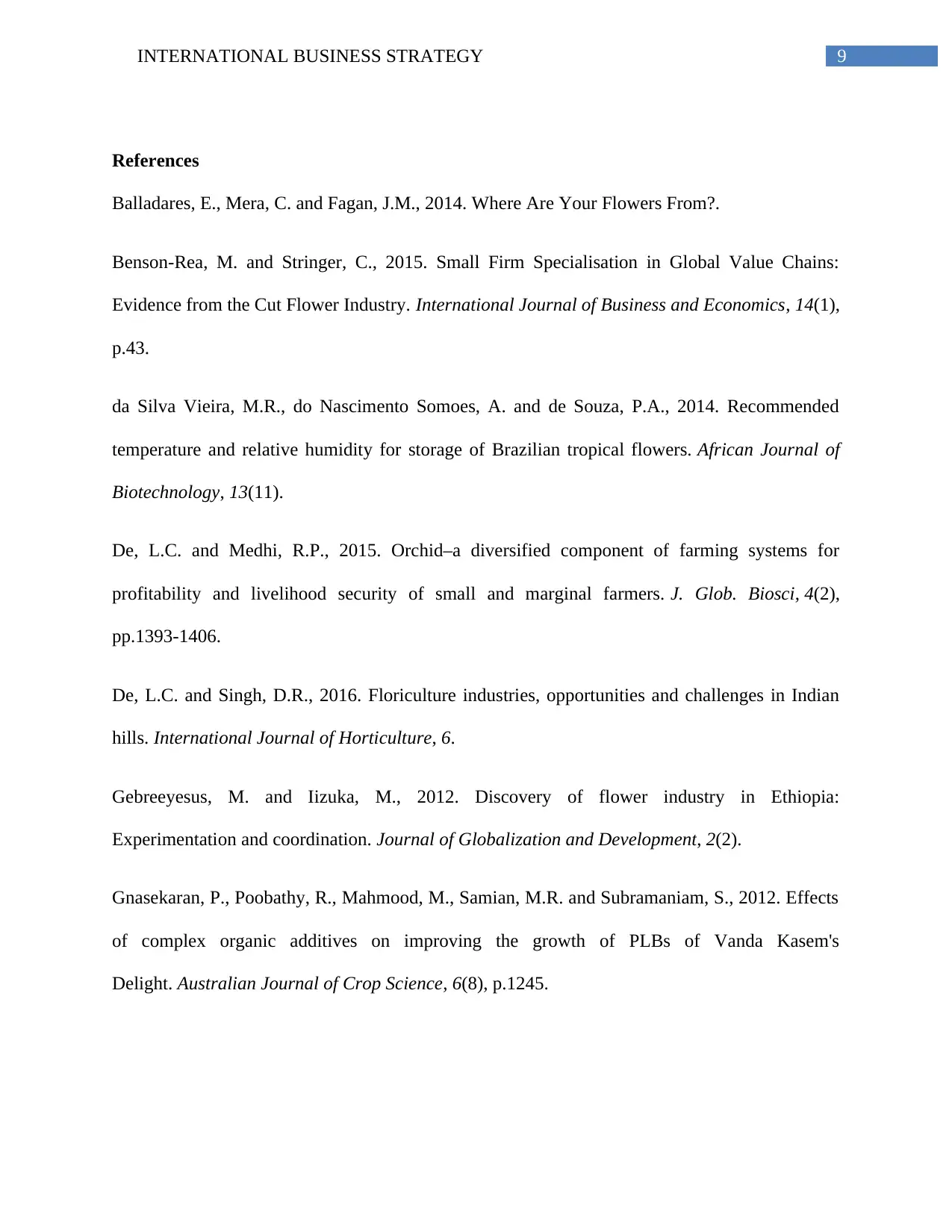
9INTERNATIONAL BUSINESS STRATEGY
References
Balladares, E., Mera, C. and Fagan, J.M., 2014. Where Are Your Flowers From?.
Benson-Rea, M. and Stringer, C., 2015. Small Firm Specialisation in Global Value Chains:
Evidence from the Cut Flower Industry. International Journal of Business and Economics, 14(1),
p.43.
da Silva Vieira, M.R., do Nascimento Somoes, A. and de Souza, P.A., 2014. Recommended
temperature and relative humidity for storage of Brazilian tropical flowers. African Journal of
Biotechnology, 13(11).
De, L.C. and Medhi, R.P., 2015. Orchid–a diversified component of farming systems for
profitability and livelihood security of small and marginal farmers. J. Glob. Biosci, 4(2),
pp.1393-1406.
De, L.C. and Singh, D.R., 2016. Floriculture industries, opportunities and challenges in Indian
hills. International Journal of Horticulture, 6.
Gebreeyesus, M. and Iizuka, M., 2012. Discovery of flower industry in Ethiopia:
Experimentation and coordination. Journal of Globalization and Development, 2(2).
Gnasekaran, P., Poobathy, R., Mahmood, M., Samian, M.R. and Subramaniam, S., 2012. Effects
of complex organic additives on improving the growth of PLBs of Vanda Kasem's
Delight. Australian Journal of Crop Science, 6(8), p.1245.
References
Balladares, E., Mera, C. and Fagan, J.M., 2014. Where Are Your Flowers From?.
Benson-Rea, M. and Stringer, C., 2015. Small Firm Specialisation in Global Value Chains:
Evidence from the Cut Flower Industry. International Journal of Business and Economics, 14(1),
p.43.
da Silva Vieira, M.R., do Nascimento Somoes, A. and de Souza, P.A., 2014. Recommended
temperature and relative humidity for storage of Brazilian tropical flowers. African Journal of
Biotechnology, 13(11).
De, L.C. and Medhi, R.P., 2015. Orchid–a diversified component of farming systems for
profitability and livelihood security of small and marginal farmers. J. Glob. Biosci, 4(2),
pp.1393-1406.
De, L.C. and Singh, D.R., 2016. Floriculture industries, opportunities and challenges in Indian
hills. International Journal of Horticulture, 6.
Gebreeyesus, M. and Iizuka, M., 2012. Discovery of flower industry in Ethiopia:
Experimentation and coordination. Journal of Globalization and Development, 2(2).
Gnasekaran, P., Poobathy, R., Mahmood, M., Samian, M.R. and Subramaniam, S., 2012. Effects
of complex organic additives on improving the growth of PLBs of Vanda Kasem's
Delight. Australian Journal of Crop Science, 6(8), p.1245.
Paraphrase This Document
Need a fresh take? Get an instant paraphrase of this document with our AI Paraphraser
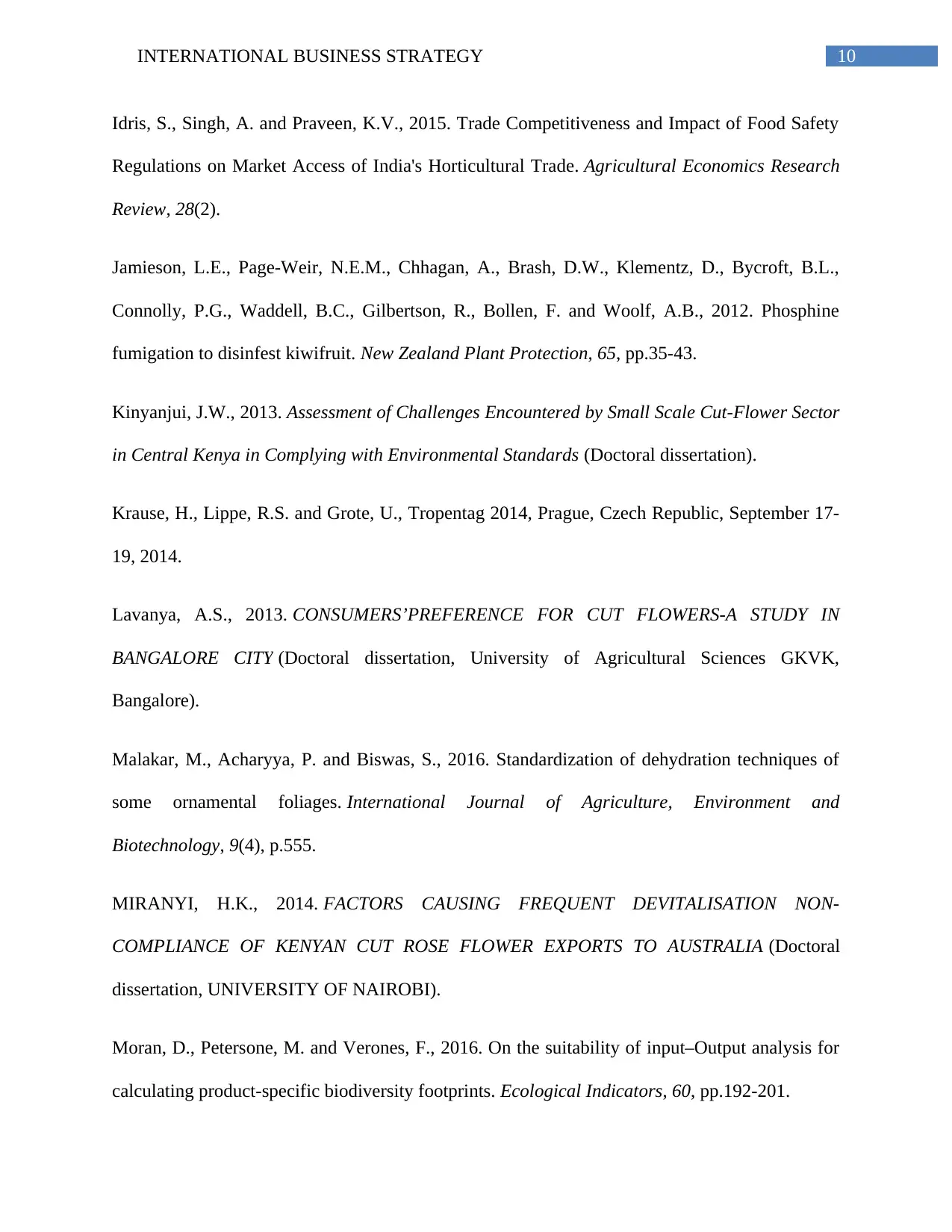
10INTERNATIONAL BUSINESS STRATEGY
Idris, S., Singh, A. and Praveen, K.V., 2015. Trade Competitiveness and Impact of Food Safety
Regulations on Market Access of India's Horticultural Trade. Agricultural Economics Research
Review, 28(2).
Jamieson, L.E., Page-Weir, N.E.M., Chhagan, A., Brash, D.W., Klementz, D., Bycroft, B.L.,
Connolly, P.G., Waddell, B.C., Gilbertson, R., Bollen, F. and Woolf, A.B., 2012. Phosphine
fumigation to disinfest kiwifruit. New Zealand Plant Protection, 65, pp.35-43.
Kinyanjui, J.W., 2013. Assessment of Challenges Encountered by Small Scale Cut-Flower Sector
in Central Kenya in Complying with Environmental Standards (Doctoral dissertation).
Krause, H., Lippe, R.S. and Grote, U., Tropentag 2014, Prague, Czech Republic, September 17-
19, 2014.
Lavanya, A.S., 2013. CONSUMERS’PREFERENCE FOR CUT FLOWERS-A STUDY IN
BANGALORE CITY (Doctoral dissertation, University of Agricultural Sciences GKVK,
Bangalore).
Malakar, M., Acharyya, P. and Biswas, S., 2016. Standardization of dehydration techniques of
some ornamental foliages. International Journal of Agriculture, Environment and
Biotechnology, 9(4), p.555.
MIRANYI, H.K., 2014. FACTORS CAUSING FREQUENT DEVITALISATION NON-
COMPLIANCE OF KENYAN CUT ROSE FLOWER EXPORTS TO AUSTRALIA (Doctoral
dissertation, UNIVERSITY OF NAIROBI).
Moran, D., Petersone, M. and Verones, F., 2016. On the suitability of input–Output analysis for
calculating product-specific biodiversity footprints. Ecological Indicators, 60, pp.192-201.
Idris, S., Singh, A. and Praveen, K.V., 2015. Trade Competitiveness and Impact of Food Safety
Regulations on Market Access of India's Horticultural Trade. Agricultural Economics Research
Review, 28(2).
Jamieson, L.E., Page-Weir, N.E.M., Chhagan, A., Brash, D.W., Klementz, D., Bycroft, B.L.,
Connolly, P.G., Waddell, B.C., Gilbertson, R., Bollen, F. and Woolf, A.B., 2012. Phosphine
fumigation to disinfest kiwifruit. New Zealand Plant Protection, 65, pp.35-43.
Kinyanjui, J.W., 2013. Assessment of Challenges Encountered by Small Scale Cut-Flower Sector
in Central Kenya in Complying with Environmental Standards (Doctoral dissertation).
Krause, H., Lippe, R.S. and Grote, U., Tropentag 2014, Prague, Czech Republic, September 17-
19, 2014.
Lavanya, A.S., 2013. CONSUMERS’PREFERENCE FOR CUT FLOWERS-A STUDY IN
BANGALORE CITY (Doctoral dissertation, University of Agricultural Sciences GKVK,
Bangalore).
Malakar, M., Acharyya, P. and Biswas, S., 2016. Standardization of dehydration techniques of
some ornamental foliages. International Journal of Agriculture, Environment and
Biotechnology, 9(4), p.555.
MIRANYI, H.K., 2014. FACTORS CAUSING FREQUENT DEVITALISATION NON-
COMPLIANCE OF KENYAN CUT ROSE FLOWER EXPORTS TO AUSTRALIA (Doctoral
dissertation, UNIVERSITY OF NAIROBI).
Moran, D., Petersone, M. and Verones, F., 2016. On the suitability of input–Output analysis for
calculating product-specific biodiversity footprints. Ecological Indicators, 60, pp.192-201.
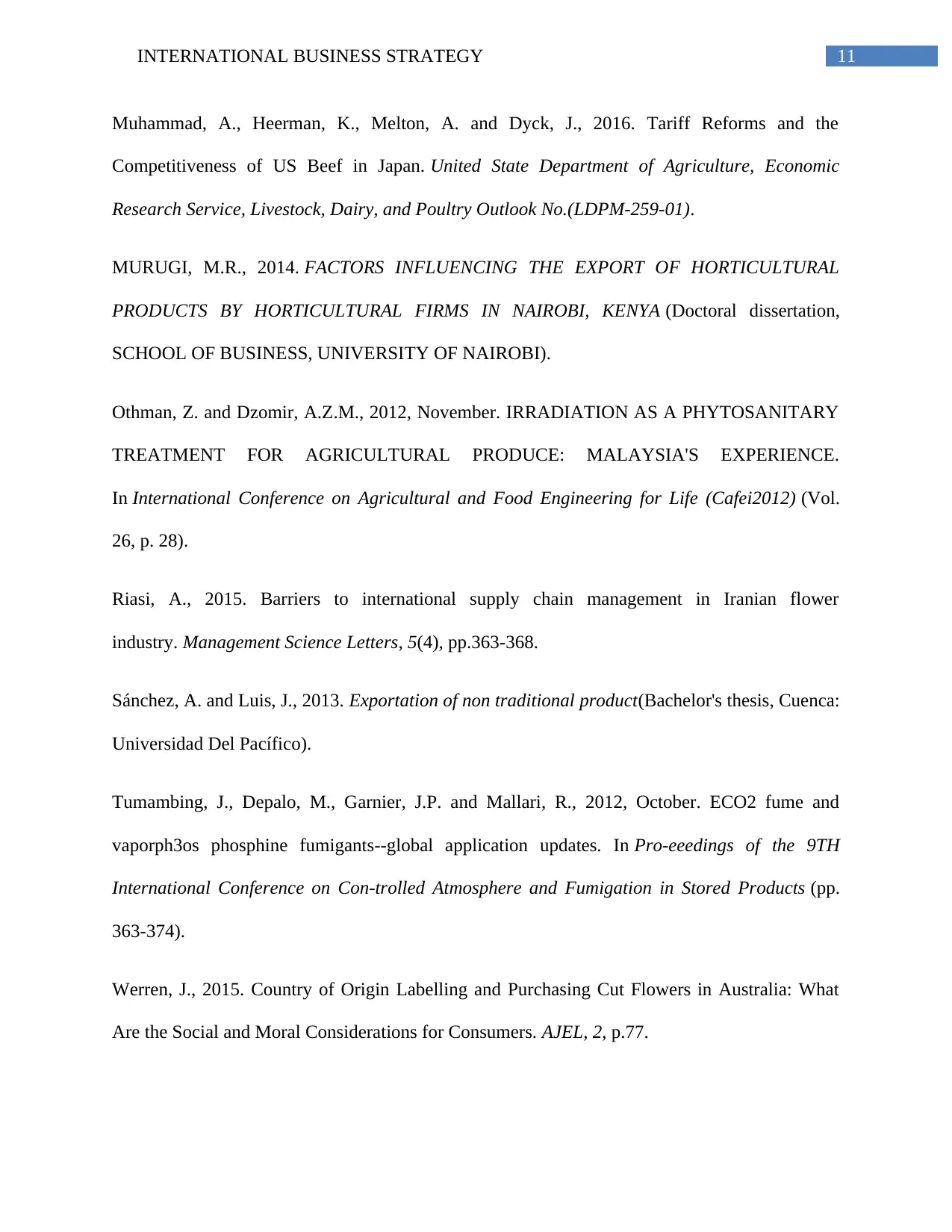
11INTERNATIONAL BUSINESS STRATEGY
Muhammad, A., Heerman, K., Melton, A. and Dyck, J., 2016. Tariff Reforms and the
Competitiveness of US Beef in Japan. United State Department of Agriculture, Economic
Research Service, Livestock, Dairy, and Poultry Outlook No.(LDPM-259-01).
MURUGI, M.R., 2014. FACTORS INFLUENCING THE EXPORT OF HORTICULTURAL
PRODUCTS BY HORTICULTURAL FIRMS IN NAIROBI, KENYA (Doctoral dissertation,
SCHOOL OF BUSINESS, UNIVERSITY OF NAIROBI).
Othman, Z. and Dzomir, A.Z.M., 2012, November. IRRADIATION AS A PHYTOSANITARY
TREATMENT FOR AGRICULTURAL PRODUCE: MALAYSIA'S EXPERIENCE.
In International Conference on Agricultural and Food Engineering for Life (Cafei2012) (Vol.
26, p. 28).
Riasi, A., 2015. Barriers to international supply chain management in Iranian flower
industry. Management Science Letters, 5(4), pp.363-368.
Sánchez, A. and Luis, J., 2013. Exportation of non traditional product(Bachelor's thesis, Cuenca:
Universidad Del Pacífico).
Tumambing, J., Depalo, M., Garnier, J.P. and Mallari, R., 2012, October. ECO2 fume and
vaporph3os phosphine fumigants--global application updates. In Pro-eeedings of the 9TH
International Conference on Con-trolled Atmosphere and Fumigation in Stored Products (pp.
363-374).
Werren, J., 2015. Country of Origin Labelling and Purchasing Cut Flowers in Australia: What
Are the Social and Moral Considerations for Consumers. AJEL, 2, p.77.
Muhammad, A., Heerman, K., Melton, A. and Dyck, J., 2016. Tariff Reforms and the
Competitiveness of US Beef in Japan. United State Department of Agriculture, Economic
Research Service, Livestock, Dairy, and Poultry Outlook No.(LDPM-259-01).
MURUGI, M.R., 2014. FACTORS INFLUENCING THE EXPORT OF HORTICULTURAL
PRODUCTS BY HORTICULTURAL FIRMS IN NAIROBI, KENYA (Doctoral dissertation,
SCHOOL OF BUSINESS, UNIVERSITY OF NAIROBI).
Othman, Z. and Dzomir, A.Z.M., 2012, November. IRRADIATION AS A PHYTOSANITARY
TREATMENT FOR AGRICULTURAL PRODUCE: MALAYSIA'S EXPERIENCE.
In International Conference on Agricultural and Food Engineering for Life (Cafei2012) (Vol.
26, p. 28).
Riasi, A., 2015. Barriers to international supply chain management in Iranian flower
industry. Management Science Letters, 5(4), pp.363-368.
Sánchez, A. and Luis, J., 2013. Exportation of non traditional product(Bachelor's thesis, Cuenca:
Universidad Del Pacífico).
Tumambing, J., Depalo, M., Garnier, J.P. and Mallari, R., 2012, October. ECO2 fume and
vaporph3os phosphine fumigants--global application updates. In Pro-eeedings of the 9TH
International Conference on Con-trolled Atmosphere and Fumigation in Stored Products (pp.
363-374).
Werren, J., 2015. Country of Origin Labelling and Purchasing Cut Flowers in Australia: What
Are the Social and Moral Considerations for Consumers. AJEL, 2, p.77.
⊘ This is a preview!⊘
Do you want full access?
Subscribe today to unlock all pages.

Trusted by 1+ million students worldwide
1 out of 13
Your All-in-One AI-Powered Toolkit for Academic Success.
+13062052269
info@desklib.com
Available 24*7 on WhatsApp / Email
![[object Object]](/_next/static/media/star-bottom.7253800d.svg)
Unlock your academic potential
Copyright © 2020–2025 A2Z Services. All Rights Reserved. Developed and managed by ZUCOL.